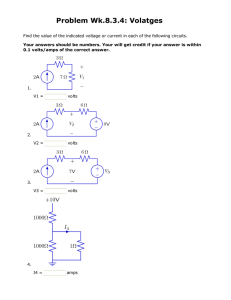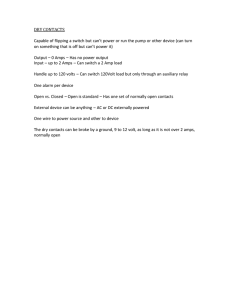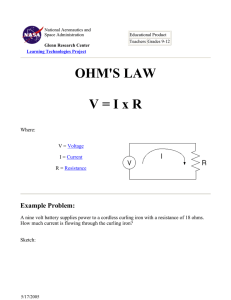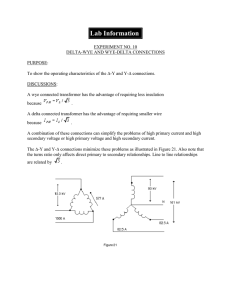RacSense Series Power Distribution RSS Installation
advertisement
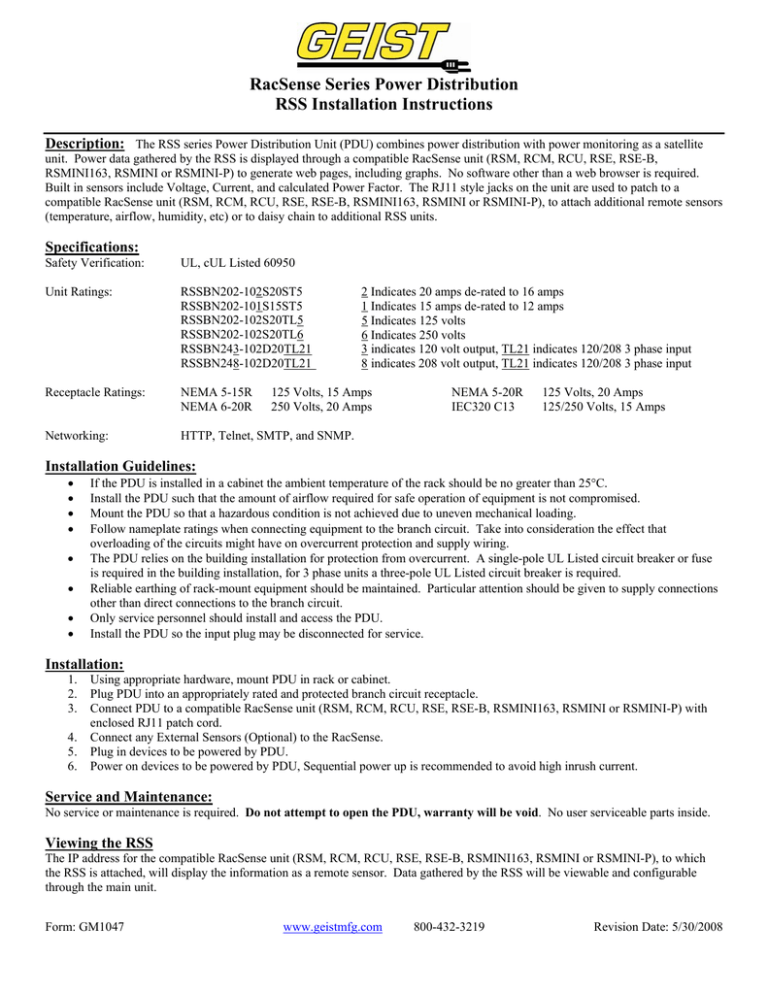
RacSense Series Power Distribution RSS Installation Instructions Description: The RSS series Power Distribution Unit (PDU) combines power distribution with power monitoring as a satellite unit. Power data gathered by the RSS is displayed through a compatible RacSense unit (RSM, RCM, RCU, RSE, RSE-B, RSMINI163, RSMINI or RSMINI-P) to generate web pages, including graphs. No software other than a web browser is required. Built in sensors include Voltage, Current, and calculated Power Factor. The RJ11 style jacks on the unit are used to patch to a compatible RacSense unit (RSM, RCM, RCU, RSE, RSE-B, RSMINI163, RSMINI or RSMINI-P), to attach additional remote sensors (temperature, airflow, humidity, etc) or to daisy chain to additional RSS units. Specifications: Safety Verification: UL, cUL Listed 60950 Unit Ratings: RSSBN202-102S20ST5 RSSBN202-101S15ST5 RSSBN202-102S20TL5 RSSBN202-102S20TL6 RSSBN243-102D20TL21 RSSBN248-102D20TL21 Receptacle Ratings: NEMA 5-15R NEMA 6-20R Networking: HTTP, Telnet, SMTP, and SNMP. 2 Indicates 20 amps de-rated to 16 amps 1 Indicates 15 amps de-rated to 12 amps 5 Indicates 125 volts 6 Indicates 250 volts 3 indicates 120 volt output, TL21 indicates 120/208 3 phase input 8 indicates 208 volt output, TL21 indicates 120/208 3 phase input 125 Volts, 15 Amps 250 Volts, 20 Amps NEMA 5-20R IEC320 C13 125 Volts, 20 Amps 125/250 Volts, 15 Amps Installation Guidelines: • • • • • • • • If the PDU is installed in a cabinet the ambient temperature of the rack should be no greater than 25°C. Install the PDU such that the amount of airflow required for safe operation of equipment is not compromised. Mount the PDU so that a hazardous condition is not achieved due to uneven mechanical loading. Follow nameplate ratings when connecting equipment to the branch circuit. Take into consideration the effect that overloading of the circuits might have on overcurrent protection and supply wiring. The PDU relies on the building installation for protection from overcurrent. A single-pole UL Listed circuit breaker or fuse is required in the building installation, for 3 phase units a three-pole UL Listed circuit breaker is required. Reliable earthing of rack-mount equipment should be maintained. Particular attention should be given to supply connections other than direct connections to the branch circuit. Only service personnel should install and access the PDU. Install the PDU so the input plug may be disconnected for service. Installation: 1. 2. 3. 4. 5. 6. Using appropriate hardware, mount PDU in rack or cabinet. Plug PDU into an appropriately rated and protected branch circuit receptacle. Connect PDU to a compatible RacSense unit (RSM, RCM, RCU, RSE, RSE-B, RSMINI163, RSMINI or RSMINI-P) with enclosed RJ11 patch cord. Connect any External Sensors (Optional) to the RacSense. Plug in devices to be powered by PDU. Power on devices to be powered by PDU, Sequential power up is recommended to avoid high inrush current. Service and Maintenance: No service or maintenance is required. Do not attempt to open the PDU, warranty will be void. No user serviceable parts inside. Viewing the RSS The IP address for the compatible RacSense unit (RSM, RCM, RCU, RSE, RSE-B, RSMINI163, RSMINI or RSMINI-P), to which the RSS is attached, will display the information as a remote sensor. Data gathered by the RSS will be viewable and configurable through the main unit. Form: GM1047 www.geistmfg.com 800-432-3219 Revision Date: 5/30/2008 Page 2 Sensors RSS sensors are measured every 10 to 30 seconds depending on the # of devices connected. Sensor data collected by the RacSense series product gives useful trend analysis data. While all values are not absolute in relation to a known unit, trend analysis of the data allows users to view changes in data value over time. Analysis of the change in value of the data can lead the user to useful conclusions about what is happening in the monitored power distribution unit. The information is repeated for each phase on a threephase unit. KWatt-Hours – A non-resettable running total of Watts multiplied by time and divided by 1000. Up to 65,535 kWhr can be measured before the counter rolls over to zero. Volts – True RMS voltage at the time accessed. Volts (Max) – Maximum RMS voltage since last accessed. Volts (Min) – Minimum RMS voltage since last accessed. Volts (Peak) – Maximum instantaneous Zero-to-Peak voltage since last accessed. Amps – True RMS amperage at the time accessed. Real Power – Volts (Instant) * Amps (Instant) averaged over a 1.5 second period. Apparent Power – Voltsrms * Ampsrms Power Factor – (Real Power / Apparent Power) * 100 Form: GM1047 www.geistmfg.com 800-432-3219 Revision Date: 5/30/2008
